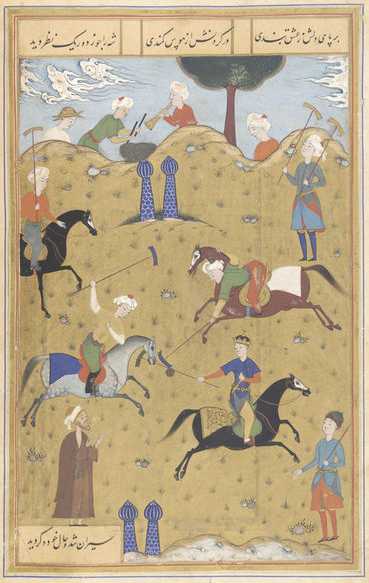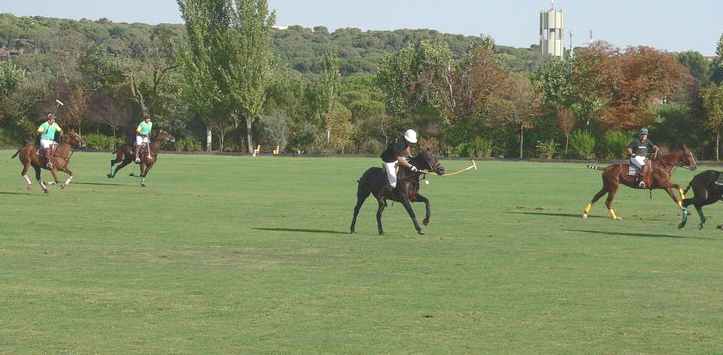|
POLO
|
||
|
HOME | BIOLOGY | FILMS | GEOGRAPHY | HISTORY | INDEX | MUSIC | SOLAR BOATS | SPORT | SPONSORS |
||
|
Polo is a team sport played on horseback where the aim is to score goals against your opponents. Riders score by driving a ball into the opposing team's goal using a long-handled mallet. Goals are only valid if the scoring rider is mounted. When played outdoors, each Polo team fields a team of four riders and their mounts. In the indoor variant ("Arena Polo"), each team fields only 3 players. In both versions of the sport, play occurs in seven-minute periods, called chukkers. Six chukkers is considered the norm, but depending on league rules, matches can also have four or eight chukkers.
Polo image from illustrated poem Guy u Chawgan
Origins
This verse is inscribed on a stone tablet next to a polo ground in Skardu (Pakistan), north of Kashmir, near the fabled silk route from China to the West. In one ancient sentence, it epitomises the feelings of many polo players today.
The word polo is Balti for ball. Polo was probably developed first in Skardu (Baltistan), Ladakh (northern Pakistan), the Kargil area of India, and in a few places of Tibet and Nepal. The earliest evidence of polo is found in a 4000-4500 year-old Balti story named 'Hilafoo Kaisaar'. In northern Pakistan, where Polo is still played in its original form (free-style), a local variant is called Chogan.
However, many scholars believe that polo originated among the Iranian tribes [1] sometime before Darius I (521–485 BC) and his cavalry extended the Achaemenid rule to greater Persia. Certainly Persian literature and art give us the richest accounts of polo in antiquity.
Ferdowsi, the famed Iranian poet-historian, gives a number of accounts of royal polo tournaments in his 9th century epic, Shahnameh (the Epic of Kings). In the earliest account, Ferdowsi romanticizes an international match between Turanian force and the followers of Siyâvash, a legendary Persian prince from the earliest centuries of the Empire. The poet is eloquent in his praise of Siyâvash's skills on the polo field. Ferdowsi also tells of Emperor Shapur II of the Sassanid dynasty of the 4th century, who learned to play polo when he was only seven years old.
Wherever its precise origins, polo seems to have spread throughout the Iranian plateau, Asia Minor, China and the Indian subcontinent along with the use of light cavalry. Some people erroneously believe that the strongly equestrian Mongol hordes invented polo. However, The Mongol Empire and the rise of the Golden Horde occurred almost a full millenia after polo had been well-established in Asia and the Iranian plateau. Still, the Mongols did play a variant of polo — with the head of a goat instead of a ball.
Polo was also popular in China, where it was the royal pastime for many centuries. The Chinese probably learned the game from the Iranian nobles who sought refuge in Chinese courts after the invasion of the Iranian Empire by the Arabs. Alternatively, Indian tribes (who had been taught by the Iranians) may have taught the Chinese. The polo stick appears on Chinese royal coats of arms, and the game was part of the court life in the golden age of Chinese classical culture under Minghuang, the Radiant Emperor, who was an enthusiastic equestrian.
before modern times, no variant of polo ever appeared in the European peninsula, probably because Europe's military forces depended on heavy armored cavalry, as opposed to the light, highly mobile cavalry of that Asian armies had employed since at least Alexander's time.
Throughout Asian antiquity, from Japan to Egypt, from India to the Byzantine Empire, Polo and its variants were the nearest equivalents to a "national sport." However, as the great Eastern empires decayed and collapsed in the Middle Ages following their decimation by the Mongol hordes, so too disappeared the glittering court life of which polo was so important a part, and the game itself was preserved only in remote villages.
Introduction to the Occident
Polo came to the west via Manipur, a northeastern state in India. The Guinness Book of Records in its 1991 edition (page 288) traces the origins of the game to Manipur, circa 3100 BC, where it was known as Sagol Kangjei. According to historical accounts, one British government official stationed in Manipur (then a princely state) during the late 19th century wrote an account of the sport, and thus its popularity spread.
As further proof, it is recorded during the House of Lords debate on Juvraj Tikendrajit's trial on 22nd June 1891, the Marquess of Ripon said about Manipur "it is a small State (Manipur), probably until these events took place very little known to your Lordships, unless, indeed, some of you may have heard of it as the birth place of the Game of Polo."
The 10th Hussars at Aldershot, Hants, introduced polo to England by the Argentines, in 1869. The game's governing body in the United Kingdom is the Hurlingham Polo Association, which drew up the first set of formal British rules in 1874, many of which are still in existence.
The sport became popular amongst European nobility, but during the early part of the 20th century, under the leadership of Harry Payne Whitney, polo changed to become a high-speed sport in the United States, differing from the game in England, where it involved short passes to move the ball toward the opposition's goal. Whitney and his teammates used the fast break, sending long passes downfield to riders who had broken away from the pack at a full gallop. The Contemporary Sport
Polo is now an active sport in 77 countries, and although its tenure as an Olympic sport was limited to 1900–1939, in 1998 the International Olympic Committee recognised it as a sport with a bona fide international governing body, the Federation of International Polo.
Polo is, however, played professionally in only a few countries, notably Argentina, England, Pakistan, India, and the United States. Polo is unique among team sports in that amateur players, often the team patrons, routinely hire and play alongside the sport's top professionals.
Argentina dominates the professional sport, as its polo team has been the uninterrupted world champion since 1949 and is today the source of most of the world's 10 goal (i.e., top-rated) players. It is also the source of the Raza Polo Argentino, the only purpose-bred polo pony in general international demand. In the world of polo, Argentina's Heguy family are to polo what the Barrymore family is to acting or the Khan family to squash. The Campeonato Argentino Abierto de Polo tournament, over 100 years old and still going strong, remains one of the most important polo competitions in the world.
The U.S. is unique in possessing a professional women's polo league, the United States Women's Polo Federation, which was founded in 2000. The sixteen-team league plays across the country.
The modern sport has had difficulty grappling with the traditional social and economic exclusivity associated with a game that is inevitably expensive when played at a serious level. On the one hand, many polo athletes genuinely desire to broaden public participation in the sport, both as an end in itself and to increase the standard of play. On the other hand, many members of polo clubs, particularly social or non-playing members, are attracted to the sport precisely because of its aura of wealth and exclusivity.
Nevertheless, the popularity of polo has grown steadily since the 1980s, and its future appears to have been greatly strengthened by its return as a varsity sport at universities across the world. Recently, in commonwealth countries such as Canada, a modern incarnation of polo has gained popularity. Bulahla, an updated urban equivalent, is rapidly expanding and varsity teams have been created at The University of Western Ontario, McMaster University and McGill University.
Arena (or Indoor) Polo is an affordable option for many who wish to play the sport and the rules are similar. The sport is played in a 300 ft by 150 ft enclosed arena, much like those used for other equestrian sports; the minimum size is 150 ft by 75ft. There are many arena clubs in the United States, where real estate is at a premium, and most major polo clubs, including the Santa Barbara Polo & Raquet Club, have active arena programs. The major differences between the outdoor and indoor games are speed (outdoor being faster), physicality/roughness (indoor/arena is more physical), ball size (indoor is larger), goal size (because the arena is smaller the goal is smaller), and some penalties. In the United States and Canada, collegiate polo is arena polo; in the UK collegiate polo is both..
Rules
Polo requires two teams of players mounted on horseback to play the game. When playing outdoors each team has four players, whereas arena polo is restricted to three players per team. The field is 300 yards long, and either 160 yards or 200 yards wide. There is a goal on both ends of the field. The object of the game is to score the most goals by hitting the ball through the goal.
A game is divided into periods, called chukkers (since 1898, from Hindi chakkar from Sanskrit cakra "circle, wheel", compare chakra), of 7 minutes, and depending on the rules of the particular tournament or league, a game may have 4, 6 or 8 chukkers, 6 chukkers being most common. Games are often played with a handicap in which the sum of the individual players' respective handicaps are compared. The team with the larger handicap is given free points before the start of the game. Notable international polo players
Other facts about polo
LINKS
A - Z SPORTS INDEX
A taste for adventure capitalists
Solar Cola - a healthier alternative
|
||
|
This
website
is Copyright © 1999 & 2006 NJK. The bird |
||
|
AUTOMOTIVE | BLUEBIRD | ELECTRIC CARS | ELECTRIC CYCLES | SOLAR CARS |

